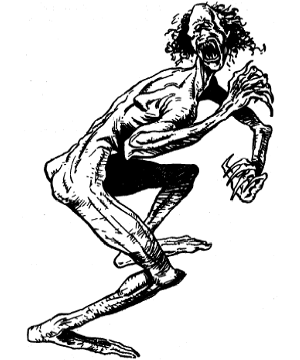

2116

| Tigbanua Buso | Tagamaling Buso | |
|---|---|---|
| Climate/Terrain: | Any nonarctic forests and mountains | Any |
| Frequency: | Uncommon | Uncommon |
| Organization: | Pack | Pack |
| Activity Cycle: | Night | Night |
| Diet: | Carnivore | Carnivore |
| Intelligence: | Animal (1) | Animal (1) |
| Treasure: | Nil | Nil |
| Alignment: | Chaotic evil | Chaotic evil |
| No. Appearing: | 1-6 | 1-6 |
| Armor Class: | 4 | 5 |
| Movement: | 12 | 12 |
| Hit Dice: | 8+2 | Special |
| THAC0: | 13 | Special |
| No. of Attacks: | 3 | 3 |
| Damage/Attack: | 1-6/1-6/1-10 | 1-4/1-4/1-8 |
| Special Attacks: | See below | Nil |
| Special Defenses: | Nil | Nil |
| Magic Resistance: | Nil | Nil |
| Size: | M (7’ tall) | M (5-6’ tall) |
| Morale: | Average (10) | Average (10) |
| XP Value: | 2,000 | Varies |
Fearsome, ghoul-like creatures, buso were once friendly and helpful to humans, but have since become one of mankind’s deadliest enemies.
Tigbanua buso, the most common variety, are exceptionally tall and lean, having long bodies and long necks which some can twist to see behind them. Their feet are bony and oversized, and their gnarled fingers end in sharp claws. Their hair is curly and dirty, their noses are flat, and their mouths are lined with sharp fangs. Filth and grime cakes their pale, leathery skin. All buso have a single red or yellow eye centered in their heads.
Combat: Tigbanua buso radiate an aura of fear with a 10-foot-radius, which automatically paralyzes creatures of less than 1 HD. Creatures of 1 HD or more must make a successful save vs. paralyzation to avoid this effect. Victims of the fear aura remain paralyzed as long as they stay within 10 feet of the buso. When they leave the area, the paralyzation wears off in 3-8 (1d6+2) rounds. Remove paralysis or a similar spell may also restore mobility.
Not noted for their intelligence, tigbanua buso make crude attacks by leaping at lone travelers and helpless villagers under the cloak of night. They are extremely ferocious and attack whenever the opportunity presents itself. They attack with their sharp claws and fangs. The claws of a tigbanua buso transmit a horrible disease, and all victims of a claw attack must make a successful saving throw vs. death or become infected. Those infected eventually become tagamaling buso (see below).
Though buso resemble ghouls, they are not undead and are subject to all attack forms, including sleep and charm spells. All weapons inflict normal damage.
Habitat/Society: The origin of the tigbanua buso is the subject of much speculation. According to rumor, they once were a peace-loving race, whose sophisticated civilization sprawled along the southern mountain regions of Shou Lung. Since then, the buso have spread throughout Kara-Tur, with small packs settling near cemeteries, in desolate forests, and in rocky mountains.
Buso have no permanent lairs, roaming from area to area in search of victims. They collect no treasure.
Ecology: Buso are insatiable scavengers. They eat the flesh of any humanoid or animal, but consider carrion excavated from cemeteries to be a delicacy.
Tagamaling Buso
Tagamaling are the unfortunate victims of a tigbanua buso’s claw attack. These victims become infected with a disease, which may transform them into a ghoulish creature every night.
A tagamaling buso resembles a somewhat shorter and thicker version of the tigbanua, lacking the tigbanua’s long neck and lean body. In most other respects, the tagamaling is identical to the tigbanua, sharing its bony feet, clawed hands, sharp fangs, and single eyeball.
Each night after he has been infected, the victim may become a tagamaling when the sun sets. The chance is 1% the first night, and increases by 1% each subsequent night. (On night two, the chance is 2%; on night 3 it is 3%, etc.) Once transformed, the victim becomes savage and mindless, attacking (and devouring) every opponent he can get his claws on. The tagamaling has the same Hit Dice and hit points he had before the transformation. Characters with special abilities, including the use of magic, cannot use such powers when transformed. Their minds are filled only with rage and animal lusts.
Twamaling buso have sharp claws and teeth like the tigbanua, but they cannot inflict disease nor do they radiate a fear aura. A transformed victim remains in the form of a tagamaling until dawn, at which time he resumes his normal form. The victim has no memory of any actions taken as a tagamaling.
Cure disease or a similar spell can negate this disease. However, once the disease reaches 100% (i.e., the victim has been infected for 100 consecutive days), the victim can no longer be cured and automatically assumes his tagamaling form every night.

◆ 240 ◆